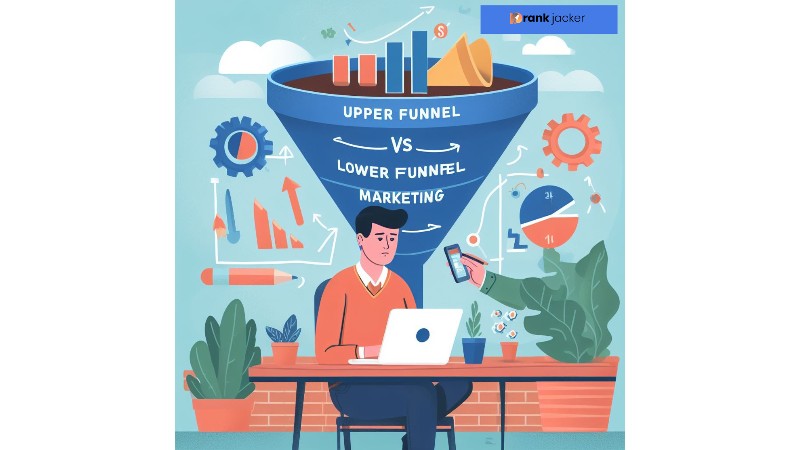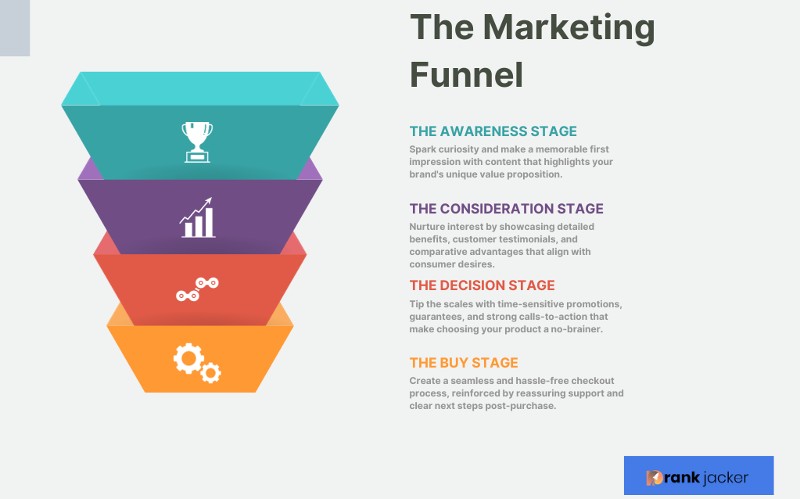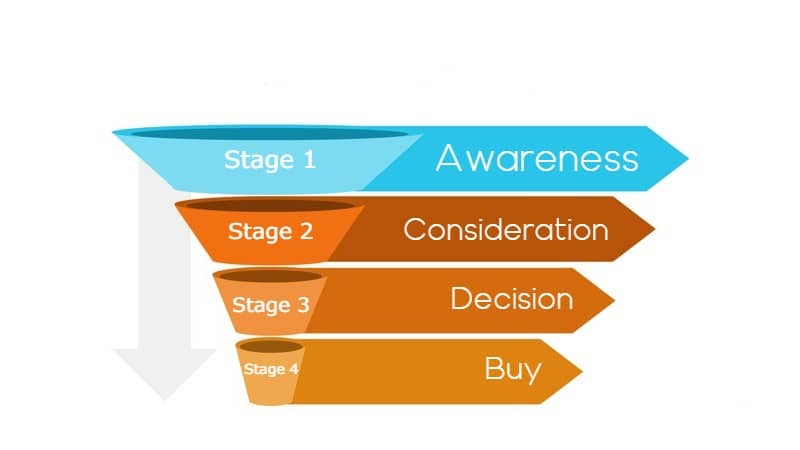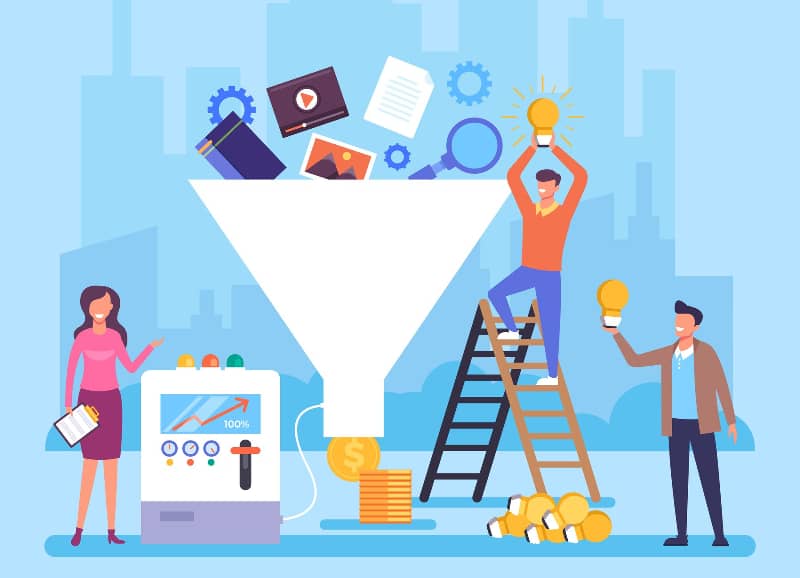By Rank Jacker on February 2, 2023

“Whether selling a service online or encouraging the visitors to sign up for your newsletter, everything revolves around funnel marketing- thus, understanding its concepts is essential!”
As a marketer, you’re a strategist at the chessboard of visitor engagement, where every move should be intentional, and every piece plays a crucial role.
In the marketing game, your pawns could be seen as “upper funnel marketing tactics,” setting the stage and reaching out far and wide. At the same time, your queen might be akin to “lower funnel marketing tactics,” powerful and decisive in driving the victory.
But understanding the strengths and nuances of each piece – or each funnel phase – can lead to a checkmate in the marketplace. In this article, I will walk you through funnel marketing and the difference between the upper and lower funnel.
“In a nutshell, upper funnel marketing targets a wide audience to build awareness and interest with informative and engaging content, while lower funnel marketing zeroes in on ready-to-buy individuals with targeted, conversion-focused tactics to drive sales. The former expands reach, and the latter capitalizes on it, turning interest into action.”
Bonus: You will also find information on how to craft a cohesive strategy to make your marketing funnel a massive success.

At its core, the marketing funnel is an illustrative representation of the customer journey, a blueprint that depicts the gradual stages of conversion from a potential prospect to a loyal customer.
In reality, the customer journey is complex and varied, but the marketing funnel provides a simplified framework to marketers, easing their jobs. You can use a funnel to:
All this assists you in creating a highly effective marketing strategy for achieving better sales and building a robust customer base. Let’s have a look at the different stages of a marketing funnel to understand the upper and lower funnel better:

Think of the top of the funnel as a big, friendly wave hello to people who might like what you’re selling but don’t know you yet. In this stage, you’re just trying to get seen. It’s like holding up a sign at a crowded concert so your friends can find you. But instead of friends, it’s potential customers, and instead of a concert, it’s the internet or other places where you can advertise.
You can use upper funnel awareness tactics to get your brand in front of as many eyes as possible. This could include social media posts, blog articles, guest posts, webinars, or ads—all designed to introduce your brand and offer value.
Now that people have noticed you, the mid-funnel marketing is where they start thinking about whether you could be the answer to their needs or problems. You’ve got their attention, and now you must provide more detailed information that positions your product or service as a potential solution.
You might share stories about why your service or product is great or how it can benefit them. Comparison content, case studies, product demos, and more in-depth articles work well to provide more detailed information that positions your product or service as a potential solution.
Also Read: How To Drive Traffic To Your Website – 5+ DIGITAL WAYS
At this point, potential customers are narrowing their choices and deciding who to buy from. They’re almost ready to make a purchase but need a little more convincing that you’re the right choice.
You can offer testimonials, reviews, or free trials. Special promotions, discount codes, or limited-time offers can also effectively nudge them toward choosing your product or service.
This is the final stage of funnel marketing, where you get your customers. Here, your prospective customer needs to be convinced to buy the product/service after carefully reviewing every bit of information you have used in your marketing stages.
The solutions need to be detailed to succeed in this stage. The Buy Stage is the lower funnel marketing stage, explicitly focusing on converting leads into customers or clients.

Now that you have an idea of what the upper and lower funnel look like and their purpose let’s explore what differentiates them. Below, I have broken down the detailed difference between both marketing funnel stages:
Upper Funnel
In the upper funnel, the primary goal is to spread awareness. Marketers want the world to learn about their brand and understand what makes it tick. It’s about getting the word out and sparking interest.
The approach is more about educating the audience on the brand or the problem the brand’s product/service can solve. At this stage, a business lays the groundwork for a relationship with potential customers.
Lower Funnel
Lower funnel marketing has a different set of goals. It zeroes in on turning that initial interest into action—actual sales. Here, the aim is to convince the audience that not only does the brand have the solution to their problem, but it’s also the best one available.
The strategy revolves around nudging those who are already considering a purchase to go ahead and take the leap. In essence, the lower funnel is where the brand’s promises are transformed into tangible results.
Upper Funnel
The top-of-the-funnel marketing tactics and channels used are broad and varied. Brands might use storytelling through social media, engaging blog posts, and SEO for broad terms that drive traffic. The idea is to maximize visibility and attract as many potential customers as possible.
Lower Funnel
On the flip side, lower funnel tactics are all about conversion. This is where the specificity of pay-per-click (PPC) campaigns, detailed product information, and targeted offers come into play.
Marketing channels are chosen for their ability to reach potential customers who have shown a clear interest in what’s being offered, such as through remarketing campaigns or personalized email marketing.

Upper Funnel
Upper funnel marketing speaks to a wider audience—anyone who might have a passing interest in what the brand has to offer. It’s not personalized but rather aimed at casting a wide net to pull in as many leads as possible.
Lower Funnel
Lower funnel marketing is the opposite. It’s highly targeted, focusing on a much smaller group of people. These are the ones who’ve engaged with the brand already, maybe by visiting the website or signing up for a newsletter. They’ve shown interest and are considered potential customers who just need that final push.
Upper Funnel
Success in the upper funnel is measured in broad strokes: how many people have seen the brand, the amount of traffic to the website, and engagement levels with content. These metrics give an idea of the brand’s reach and how effectively it’s drawing people in.
Lower Funnel
In the lower funnel, the metrics get more specific. They’re all about the return on investment (ROI). Success is measured by conversion rates, sales, and profits.
These numbers show not just how many people are coming to the site but how many are actually spending money.
Upper Funnel
Content at the upper end of the funnel is designed to inform, engage, and often entertain. It’s about answering questions the audience didn’t even know they had and introducing them to the brand’s world. The tone is informative and helpful, aimed at showing the audience the brand understands their needs and challenges.
Lower Funnel
When you reach the lower funnel, the content changes drastically. It’s now about persuasion. The messaging includes a clear call to action, urging the audience to make a purchase.
It’s more direct, with content like product demos, customer testimonials, and competitor comparisons. It’s the brand’s opportunity to say, “Here’s why you need this product in your life now,” and to seal the deal.
If not properly integrated, the upper funnel can fail to send the visitors down into the lower funnel, which means fewer or zero conversions.
A well-integrated funnel ensures that no part of your customer’s journey feels disjointed or out of sync with their needs and expectations. Here’s how you can combine the two for a comprehensive approach:
The key to integrating upper and lower-funnel marketing lies in creating a seamless transition. It means that the educational content provided in the upper funnel should naturally lead to the more conversion-focused content of the lower funnel.
For instance, a blog post or a press release (upper funnel) that discusses the benefits of a product could link to a product comparison chart or a demo sign-up page (lower funnel), encouraging readers to take the next step.
Consistency in messaging reinforces brand recall. The tone, style, and core messages established at the upper funnel should carry through to the lower funnel. If the upper funnel content has positioned the brand as a thought leader, the lower funnel should build on this by showcasing the brand’s expertise and reliability, leading to a purchase decision.
You can collect data at each stage of the funnel to tailor future interactions. For example, if a user reads a general informational piece at the top of the funnel and later a more detailed guide in the middle, this indicates a deepening interest.
By the time they reach the lower funnel, marketers can use this data to present personalized product recommendations or targeted offers that match the user’s interests.
Retargeting is a powerful tool for connecting upper and lower funnel strategies. By retargeting ads toward individuals who have engaged with upper-funnel content but haven’t made a purchase, brands can keep the conversation going.
These ads should be more specific, reflecting the potential customer’s journey and pushing toward decision-making.
The customer experience should be consistent across all touchpoints. Whether a potential customer is engaging with a brand’s content on social media (the upper funnel) or receiving a targeted email (the lower funnel), the transition should feel like a natural next step, not a disruptive shift.
Finally, a cohesive strategy requires integrating across channels. A potential customer might first encounter a brand through a social media ad, read more via a blog post, and finally make a purchase after clicking on a retargeted ad or an email link.
Each channel should support the other with cross-channel campaigns that guide the customer through the funnel.
Finding it difficult to integrate the upper and lower funnel for an effective marketing strategy? Let Rank Jacker help you with all your requirements. Contact us today, and we’ll break down your funnel marketing strategy to tell you why it is not working as you expected.
Wrapping It Up:
I hope this guide on lower funnel vs upper funnel marketing has helped you understand the difference and importance of each. Whether it is the top or the bottom funnel, there should be an exemplary integration for any business to get the attention of its prospects and convert them into loyal customers.
The most effective marketing funnel is not just about targeting customers at each stage but creating a journey that feels natural and responsive to their needs.
If you found this article helpful, make sure to subscribe to our newsletter and never miss out on the latest market trends.
Additional Articles
What Is Top Of The Funnel Marketing?
Esse suscipit et.
02.05.23
Upper Funnel Vs. Lower Funnel Marketing: A Guide To Key Differences And Winning Strategies
“Whether selling a service online or encouraging the visitors to sign up for your newsletter, eve...
02.02.23
IF NOT NOW, THEN WHEN?
BOOK A CALL TODAY